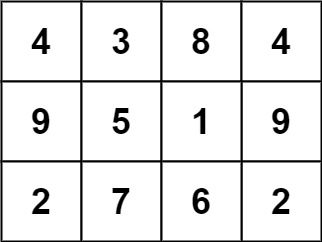Description
A 3 x 3 magic square is a 3 x 3 grid filled with distinct numbers from 1 to 9 such that each row, column, and both diagonals all have the same sum.
Given a row x col grid of integers, how many 3 x 3 magic square subgrids are there?
Note: while a magic square can only contain numbers from 1 to 9, grid may contain numbers up to 15.
Example 1:

Input: grid = [[4,3,8,4],[9,5,1,9],[2,7,6,2]] Output: 1 Explanation: The following subgrid is a 3 x 3 magic square:while this one is not:
In total, there is only one magic square inside the given grid.
Example 2:
Input: grid = [[8]] Output: 0
Constraints:
row == grid.lengthcol == grid[i].length1 <= row, col <= 100 <= grid[i][j] <= 15
Solution
Python3
class Solution:
def numMagicSquaresInside(self, grid: List[List[int]]) -> int:
cnt = 0
# Construct the 3x3 square
for i in range(len(grid)-2):
for j in range(len(grid)-2):
temp_grid = [grid[i+k][j:j+3] for k in range(3)]
if self.isMagicSquare(temp_grid):
cnt += 1
return cnt
def isMagicSquare(self, grid):
'''
Check whether the given grid is a magic square
'''
# Check the elements
flat = [num for row in grid for num in row]
if sorted(flat) != [1, 2, 3, 4, 5, 6, 7, 8, 9]:
return False
# Check the row, column and diagnal sums
row_sums = [sum(row) for row in grid]
col_sums = [sum([row[i] for row in grid]) for i in range(3)]
diag_sums = [sum([grid[i][i] for i in range(3)]), (grid[0][2] + grid[1][1] + grid[2][0])]
row_sums.extend(col_sums)
row_sums.extend(diag_sums)
return len(set(row_sums)) == 1